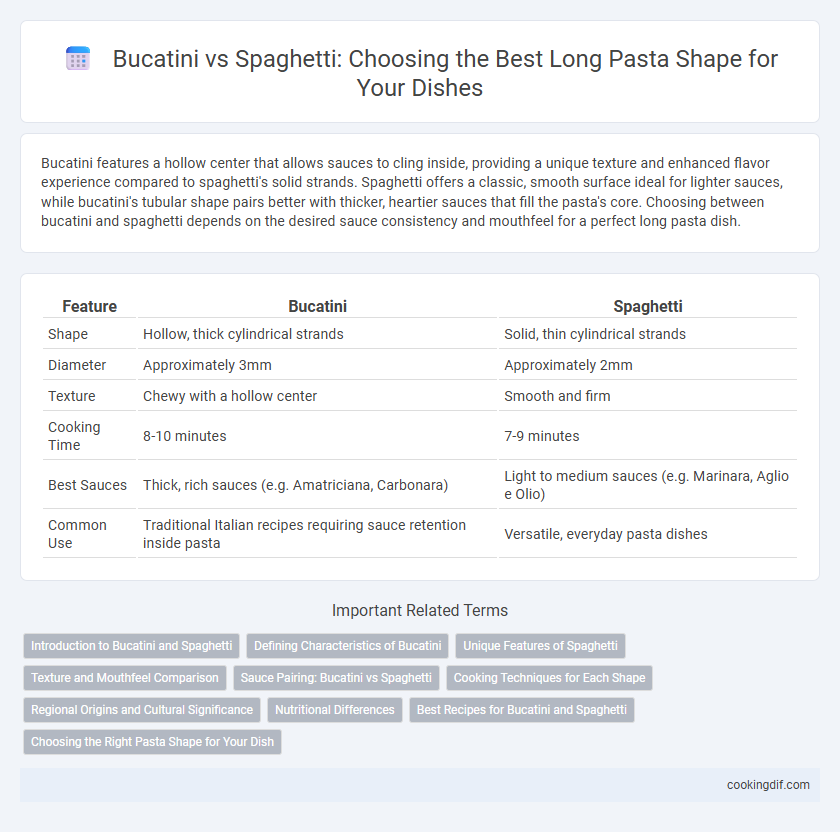Bucatini features a hollow center that allows sauces to cling inside, providing a unique texture and enhanced flavor experience compared to spaghetti's solid strands. Spaghetti offers a classic, smooth surface ideal for lighter sauces, while bucatini's tubular shape pairs better with thicker, heartier sauces that fill the pasta's core. Choosing between bucatini and spaghetti depends on the desired sauce consistency and mouthfeel for a perfect long pasta dish.
Table of Comparison
| Feature | Bucatini | Spaghetti |
|---|---|---|
| Shape | Hollow, thick cylindrical strands | Solid, thin cylindrical strands |
| Diameter | Approximately 3mm | Approximately 2mm |
| Texture | Chewy with a hollow center | Smooth and firm |
| Cooking Time | 8-10 minutes | 7-9 minutes |
| Best Sauces | Thick, rich sauces (e.g. Amatriciana, Carbonara) | Light to medium sauces (e.g. Marinara, Aglio e Olio) |
| Common Use | Traditional Italian recipes requiring sauce retention inside pasta | Versatile, everyday pasta dishes |
Introduction to Bucatini and Spaghetti
Bucatini is a thick, hollow long pasta that offers a unique texture and allows sauces to cling both inside and outside its tubular shape. Spaghetti, a classic long pasta, is solid and slender, known for its versatility and smooth surface that evenly distributes sauces. Choosing between bucatini and spaghetti depends on the desired mouthfeel and sauce pairing, with bucatini excelling in hearty, chunky sauces and spaghetti suited for lighter, smoother options.
Defining Characteristics of Bucatini
Bucatini is a thick, hollow long pasta that resembles spaghetti but features a distinctive central hole running through its length, which allows it to hold sauces more effectively. Its unique tubular shape provides a chewy texture and enhances flavor absorption, making it ideal for hearty, rich sauces like amatriciana or carbonara. Unlike traditional spaghetti, bucatini offers an added dimension of mouthfeel and sauce retention due to its hollow center.
Unique Features of Spaghetti
Spaghetti is a classic long pasta shape characterized by its thin, cylindrical strands that cook quickly and evenly, making it versatile for various sauces from light olive oil to rich tomato-based ones. Its smooth surface allows for a delicate balance with both simple and complex flavors, differentiating it from Bucatini, which has a hollow center that traps sauce inside. Spaghetti's slender profile makes it ideal for dishes like Spaghetti Carbonara or Spaghetti Aglio e Olio, where coating the strands evenly is essential for flavor harmony.
Texture and Mouthfeel Comparison
Bucatini features a hollow center that provides a unique chewy texture and allows sauces to cling inside, enhancing flavor with every bite. Spaghetti offers a smooth, firm bite with a consistent mouthfeel, making it versatile for a variety of sauces. The tubular shape of bucatini creates a richer, more complex mouthfeel compared to the streamlined texture of spaghetti.
Sauce Pairing: Bucatini vs Spaghetti
Bucatini's hollow center allows it to hold thicker, creamier sauces like carbonara or amatriciana more effectively than spaghetti, enhancing flavor absorption and texture contrast. Spaghetti, with its smooth, solid strands, pairs best with lighter, oil-based sauces such as aglio e olio or simple tomato sauces that cling evenly without overpowering the pasta. Choosing between bucatini and spaghetti largely depends on the sauce's consistency and desired flavor intensity in the dish.
Cooking Techniques for Each Shape
Bucatini requires a slightly longer cooking time than spaghetti due to its hollow center, which allows heat to penetrate the pasta more evenly, preventing undercooked interiors. Spaghetti, being solid and thinner, cooks quickly and demands constant stirring to avoid clumping and sticking. Both shapes benefit from finishing in the sauce to absorb flavors, but bucatini's tubular structure holds thicker sauces better, while spaghetti pairs well with lighter, smoother sauces.
Regional Origins and Cultural Significance
Bucatini, originating from Lazio, particularly Rome, features a hollow center that differentiates it from traditional spaghetti, enhancing sauce absorption and texture. Spaghetti, with roots tracing back to Southern Italy, especially Naples, holds iconic status in Italian cuisine due to its versatile use in numerous regional dishes like spaghetti alla carbonara and spaghetti al pomodoro. Both pasta types embody Italy's rich culinary heritage, reflecting regional preferences and historical influences in long pasta shape development.
Nutritional Differences
Bucatini contains slightly more calories and carbohydrates per serving compared to spaghetti due to its hollow center, which affects cooking time and texture absorption. Both pastas offer similar protein content, but bucatini's thickness provides a higher glycemic index, potentially influencing blood sugar levels more rapidly than spaghetti. Fiber content remains comparable, making each choice suitable depending on dietary preferences for energy release and texture.
Best Recipes for Bucatini and Spaghetti
Bucatini's hollow center makes it ideal for thick, hearty sauces like amatriciana and carbonara, allowing flavors to penetrate the pasta for a rich taste experience. Spaghetti pairs best with lighter, smooth sauces such as aglio e olio or classic marinara, offering a familiar texture that complements simple yet flavorful recipes. Both pastas shine in recipes highlighting their unique shapes and sauce-holding capabilities to enhance traditional Italian dishes.
Choosing the Right Pasta Shape for Your Dish
Bucatini offers a hollow center that holds sauces more effectively than traditional spaghetti, making it ideal for rich, chunky sauces like amatriciana. Spaghetti's solid, thin strands work best with lighter, smoother sauces such as marinara or olive oil-based dressings. Selecting between bucatini and spaghetti depends on sauce texture and desired mouthfeel to enhance your dish's overall flavor and presentation.
Bucatini vs Spaghetti for long pasta shape Infographic

 cookingdif.com
cookingdif.com